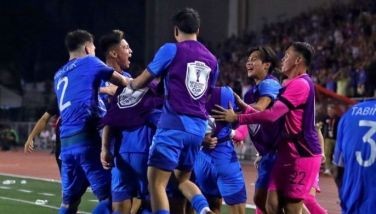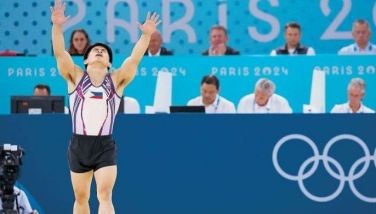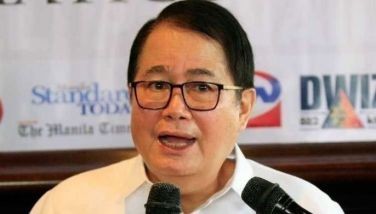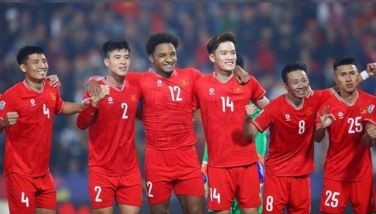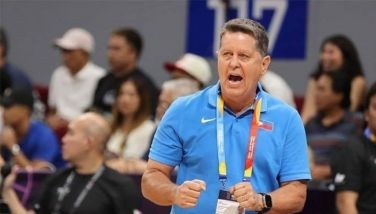China’s ‘big balls’ plan, part 2
December 17, 2005 | 12:00am
In the late 1950’s, China’s national leaders realized that sports was not only a way to improve fitness and increase output among its people, and a tool to use teamwork to preach communism, but also a means to increase its stature among nations. After closing its doors to the west, China achieved world recognition for table tennis. Still, it was not considered a mainstream sport, and this bothered the highest-ranking officers of the nation.
"Ancient Chinese sports were always performances, always art," China Central Television’s veteran sports commentator Bai Jinshen was quoted as saying in Sports Illustrated. "Sports were for health and exercise, not competition.
So it’s been a tradition for us to be better at performance sports, like diving and gymnastics and shooting, than competitive sports. Or, if the sport must be competitive, let it be table tennis and volleyball, where there’s a net. Dividing the competitors is better, so there’s not body contact." It would be decades before NBA stars like Kareem Abdul-Jabbar would be teaching the country’s youngsters about basketball psychology and trash-talking.
Even Western coaches and scientists realized that the aversion to physical contact, and the belief that the Chinese were physically inferior had no merit. Perhaps the problem was more of malnourishment, and the lack of a coordinated program that brought the country’s most physically gifted talents together. All that was about to change.
By this time, Mou Zuoyun, one of the country’s most passionate believers in basketball and now in charge of its "big ball" sports, made a huge innovation. He created a rule that all girls who showed the potential to be over 5’11" tall, and boys who could reach more than 6’7" should be recruited to play basketball for the state. Putting together manuals on how to predict a child’s height as an adult, government coaches and scouts spread out across the vast nation. In spite of the famine that followed, platoons of giant youngsters started appearing at the Soviet-style sports schools in the major cities.
You may not have heard of 6’5" Wang Weijun or 6’2" Ren Huanzhen, but they were permanently parts of Chinese national teams from the 1960’s to 1970’s, the first products of the new system. Though their skills did change the face of the Chinese teams of their day, it was their marriage and only child (born in 1977), whom people would gain greater notice of. His name is Wang Zhizhi.
Perhaps a more significant contributor to the generation of giants that followed was Yao Zhiyuan. His father, Yao Xueming, was belatedly discovered by a basketball coach during a parade in Shanghai. Yao Xueming was 6’8" but, unfortunately, was already 33 years. So the newly-formed Shanghai Sports Commission kept an eye on his oldest son, Yao Zhiyuan, instead.
Meanwhile, a thirteen-year old girl named Fang Fengdi listened as sports officials sat down with her parents in their cramped apartment and explained that, as possibly the tallest girl in Shanghai, she had the potential to bring glory to the city and the country if she played basketball. At the time, she was already more than six feet tall. The promise of better food, free education and training had no appeal for her.
"I was just a young girl who loved to sing and dance," Fang recalled in the book Operation Yao Ming. "I didn’t like basketball at all."
At any rate, Da Fang ("Big Fang") entered Shanghai’s elite sports training center, formerly the country club of rich foreigners, until Mao Tse-tung’s army swept them out. Now, the former house of leisure would become a torture chamber for young men and women who would be hammered like raw steel into the weapons of basketball dominance, or so the government hoped. The training was led by Hirofumi Daimatsu, who had shocked the world by molding Japan’s women’s volleyball team to three world championships, overcoming much taller opposition from Europe and the US.
However, Daimatsu accomplished this by fanatical and inhuman training which left many of his new Chinese recruits too tired to eat, and unwilling to complain even if they were sick or injured. Six hours of daily practice soon became eight hours, and even ten. This, coupled with indoctrination into the philosophies of Chairman Mao and other government beliefs, left them no other time, no other life.
"We’d even ask for more practice, because we worried we weren’t being revolutionary enough," explained Lu Bin, a 5’11" forward and Fang’s teammate. "If we got hurt or sick, we didn’t talk about it."
Then, after a 1966 massacre intended to "purify" his people, Mao’s government went about obliterating everything that even remotely suggested capitalism or its remnants. This included sports. The Red guards plowed under track ovals, shut down sports commissions, and imprisoned and beat the country’s greatest athletes. When the Cultural Revolution began, many of Fang’s teammates were herded off to factories to be "more productive" to the national cause. Some of the athletes who had become part of the Red Guard suddenly became drunk with power, abusing their captive former coaches to the point of not allowing them any sleep. Da Fang was one of the leaders of these groups of hot-blooded revolutionaries who channeled their youthful passions into punitive measures against their former coaches.
To be continued.
Catch this week’s episode of The Basketball Show on IBC-13 at 7 p.m. The Basketball Show is presented by adidas, Columbia International Foods, San Miguel Beer Air21.
"Ancient Chinese sports were always performances, always art," China Central Television’s veteran sports commentator Bai Jinshen was quoted as saying in Sports Illustrated. "Sports were for health and exercise, not competition.
So it’s been a tradition for us to be better at performance sports, like diving and gymnastics and shooting, than competitive sports. Or, if the sport must be competitive, let it be table tennis and volleyball, where there’s a net. Dividing the competitors is better, so there’s not body contact." It would be decades before NBA stars like Kareem Abdul-Jabbar would be teaching the country’s youngsters about basketball psychology and trash-talking.
Even Western coaches and scientists realized that the aversion to physical contact, and the belief that the Chinese were physically inferior had no merit. Perhaps the problem was more of malnourishment, and the lack of a coordinated program that brought the country’s most physically gifted talents together. All that was about to change.
By this time, Mou Zuoyun, one of the country’s most passionate believers in basketball and now in charge of its "big ball" sports, made a huge innovation. He created a rule that all girls who showed the potential to be over 5’11" tall, and boys who could reach more than 6’7" should be recruited to play basketball for the state. Putting together manuals on how to predict a child’s height as an adult, government coaches and scouts spread out across the vast nation. In spite of the famine that followed, platoons of giant youngsters started appearing at the Soviet-style sports schools in the major cities.
You may not have heard of 6’5" Wang Weijun or 6’2" Ren Huanzhen, but they were permanently parts of Chinese national teams from the 1960’s to 1970’s, the first products of the new system. Though their skills did change the face of the Chinese teams of their day, it was their marriage and only child (born in 1977), whom people would gain greater notice of. His name is Wang Zhizhi.
Perhaps a more significant contributor to the generation of giants that followed was Yao Zhiyuan. His father, Yao Xueming, was belatedly discovered by a basketball coach during a parade in Shanghai. Yao Xueming was 6’8" but, unfortunately, was already 33 years. So the newly-formed Shanghai Sports Commission kept an eye on his oldest son, Yao Zhiyuan, instead.
Meanwhile, a thirteen-year old girl named Fang Fengdi listened as sports officials sat down with her parents in their cramped apartment and explained that, as possibly the tallest girl in Shanghai, she had the potential to bring glory to the city and the country if she played basketball. At the time, she was already more than six feet tall. The promise of better food, free education and training had no appeal for her.
"I was just a young girl who loved to sing and dance," Fang recalled in the book Operation Yao Ming. "I didn’t like basketball at all."
At any rate, Da Fang ("Big Fang") entered Shanghai’s elite sports training center, formerly the country club of rich foreigners, until Mao Tse-tung’s army swept them out. Now, the former house of leisure would become a torture chamber for young men and women who would be hammered like raw steel into the weapons of basketball dominance, or so the government hoped. The training was led by Hirofumi Daimatsu, who had shocked the world by molding Japan’s women’s volleyball team to three world championships, overcoming much taller opposition from Europe and the US.
However, Daimatsu accomplished this by fanatical and inhuman training which left many of his new Chinese recruits too tired to eat, and unwilling to complain even if they were sick or injured. Six hours of daily practice soon became eight hours, and even ten. This, coupled with indoctrination into the philosophies of Chairman Mao and other government beliefs, left them no other time, no other life.
"We’d even ask for more practice, because we worried we weren’t being revolutionary enough," explained Lu Bin, a 5’11" forward and Fang’s teammate. "If we got hurt or sick, we didn’t talk about it."
Then, after a 1966 massacre intended to "purify" his people, Mao’s government went about obliterating everything that even remotely suggested capitalism or its remnants. This included sports. The Red guards plowed under track ovals, shut down sports commissions, and imprisoned and beat the country’s greatest athletes. When the Cultural Revolution began, many of Fang’s teammates were herded off to factories to be "more productive" to the national cause. Some of the athletes who had become part of the Red Guard suddenly became drunk with power, abusing their captive former coaches to the point of not allowing them any sleep. Da Fang was one of the leaders of these groups of hot-blooded revolutionaries who channeled their youthful passions into punitive measures against their former coaches.
To be continued.
BrandSpace Articles
<
>
- Latest
- Trending
Trending
Latest
Trending
Latest
Recommended














